Abstract
Serial changes in coagulation and fibrinolysis studied among 42 patients admitted to hospital with a wide variety of injuries are reported. The first hours after trauma are dominated by an acceleration of fibrinolysis (clot lysis) and clotting time which are often followed by an abrupt rebound to prolonged fibrinolysis and normal clotting. Evidence is presented that acceleration of fibrinolysis is due to flooding of the circulation by plasminogen activator and that prolongation is probably due to an inhibitor. A prolonged prothrombin time, increased prothrombin consumption index, an acceleration of the heparin-retarded clotting time, and a fall in the platelet count are also frequent during the first hours after injury. There is evidence also of an early deficiency in factor V and the onset of a fall in factor VII and prothrombin.
The following days are characterized by continued prolongation of fibrinolysis, a lengthening of clotting time, and an increased prothrombin consumption index suggestive of a defect in thrombo-plastin generation. Subsequent periods of prolonged fibrinolysis may develop. Prothrombin time often continues prolonged for one to three weeks and may vary phasically; plasma prothrombin and factor VII are reduced but there is now little change in factor V. The platelet count continues to fall for one to three days, then a thrombocytosis develops, often with abnormally high platelet levels, a week or so later. Plasma fibrinogen rises within 24 hours to reach a plateau maximum a few days later and levels remain high for prolonged periods in the severely injured. Various changes are related to or influenced by the severity of trauma. Mechanisms are discussed, including thrombosis in vivo, and reference is made to homeostatic significance and its possible breakdown.
Full text
PDF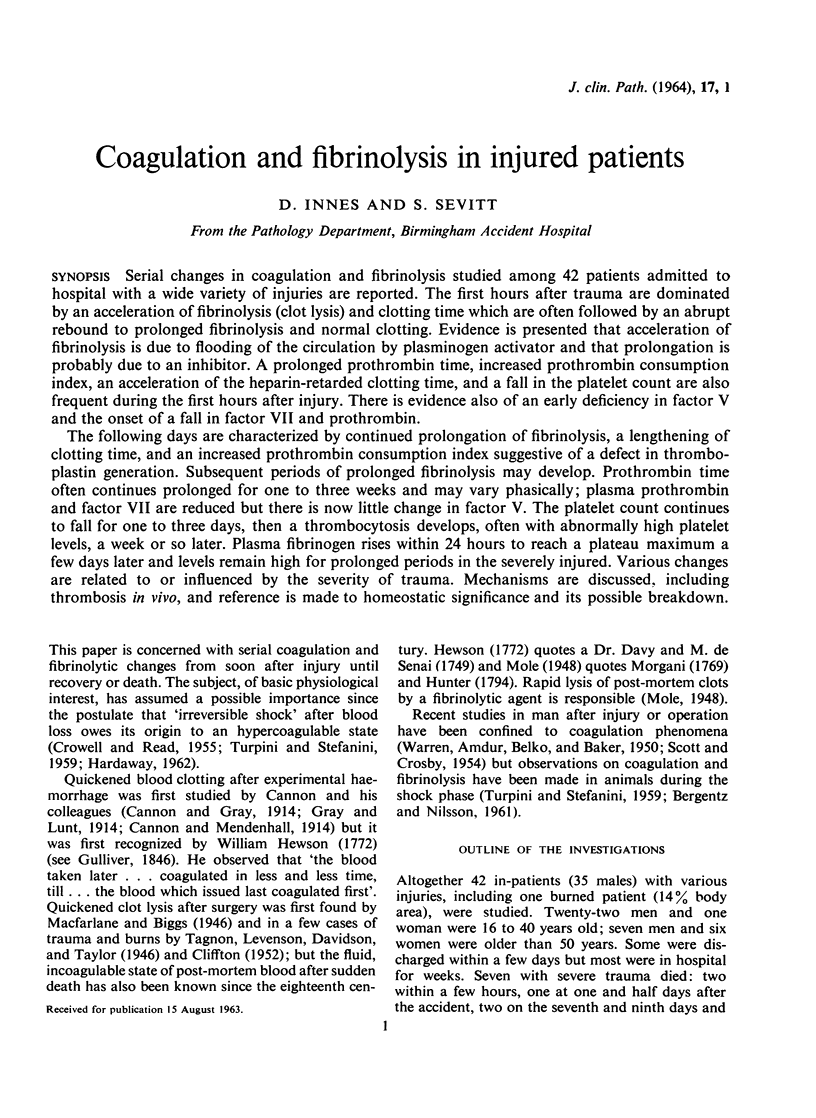
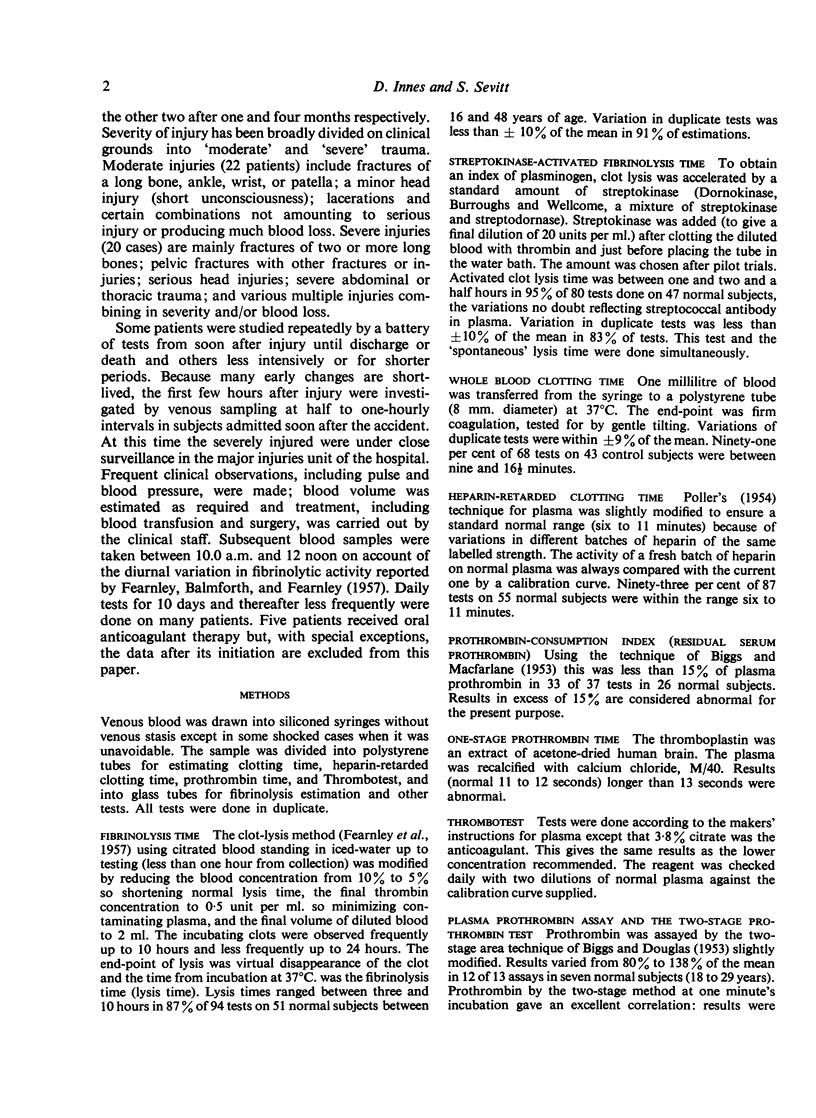
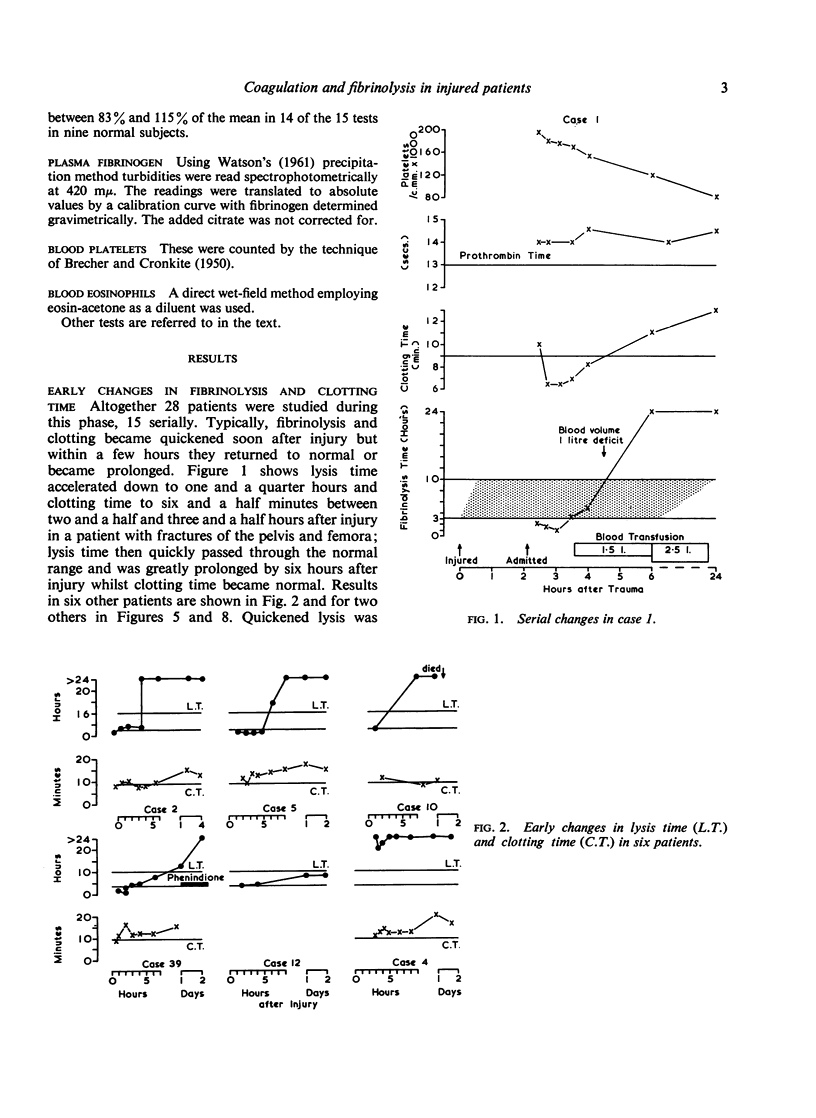
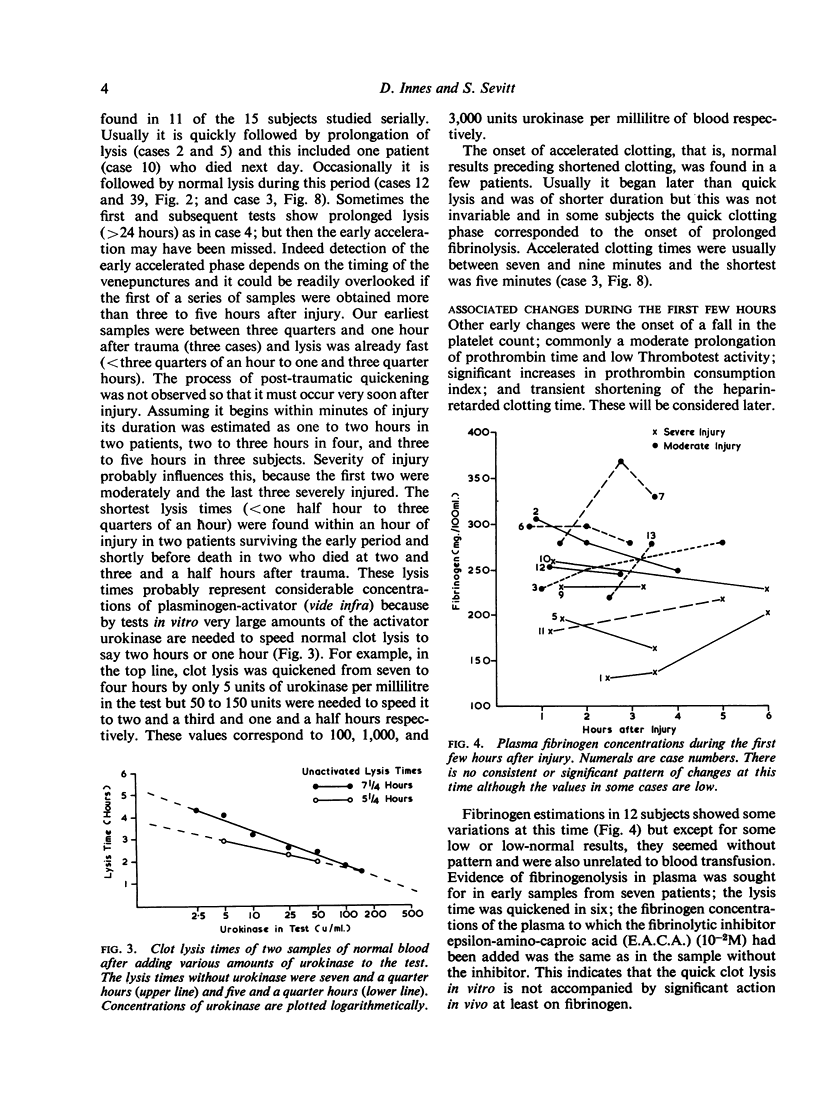
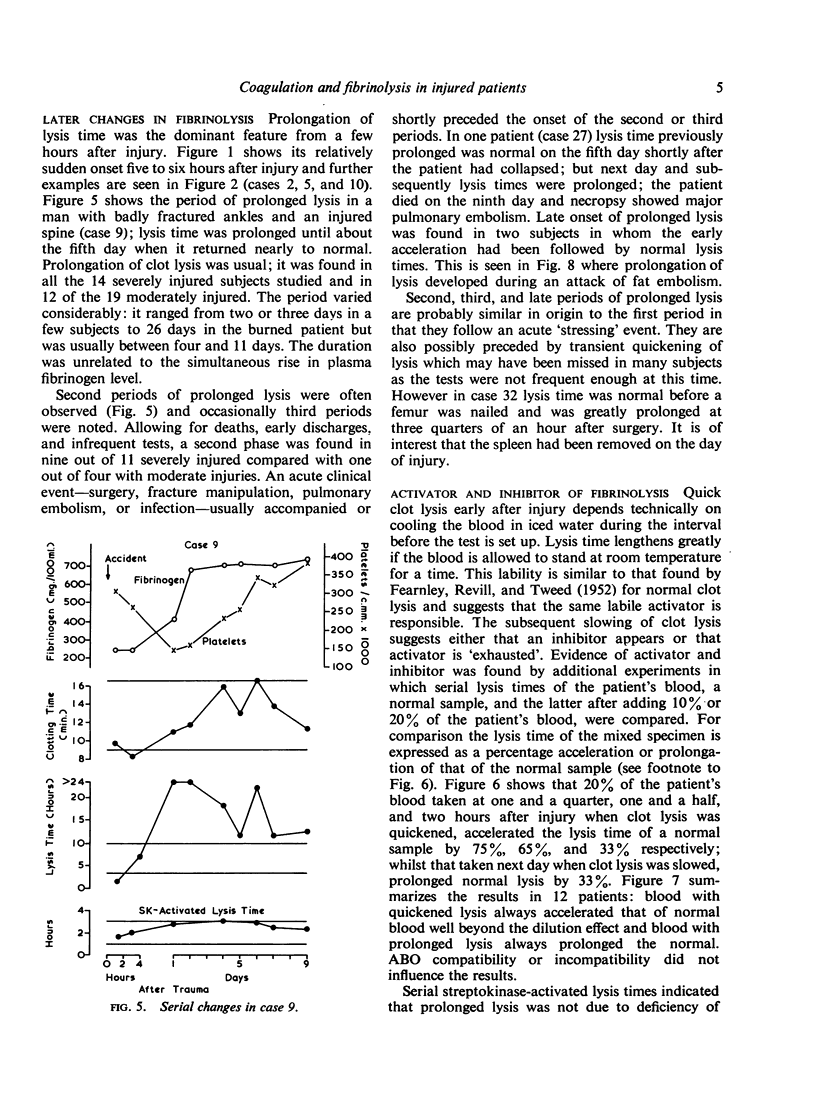
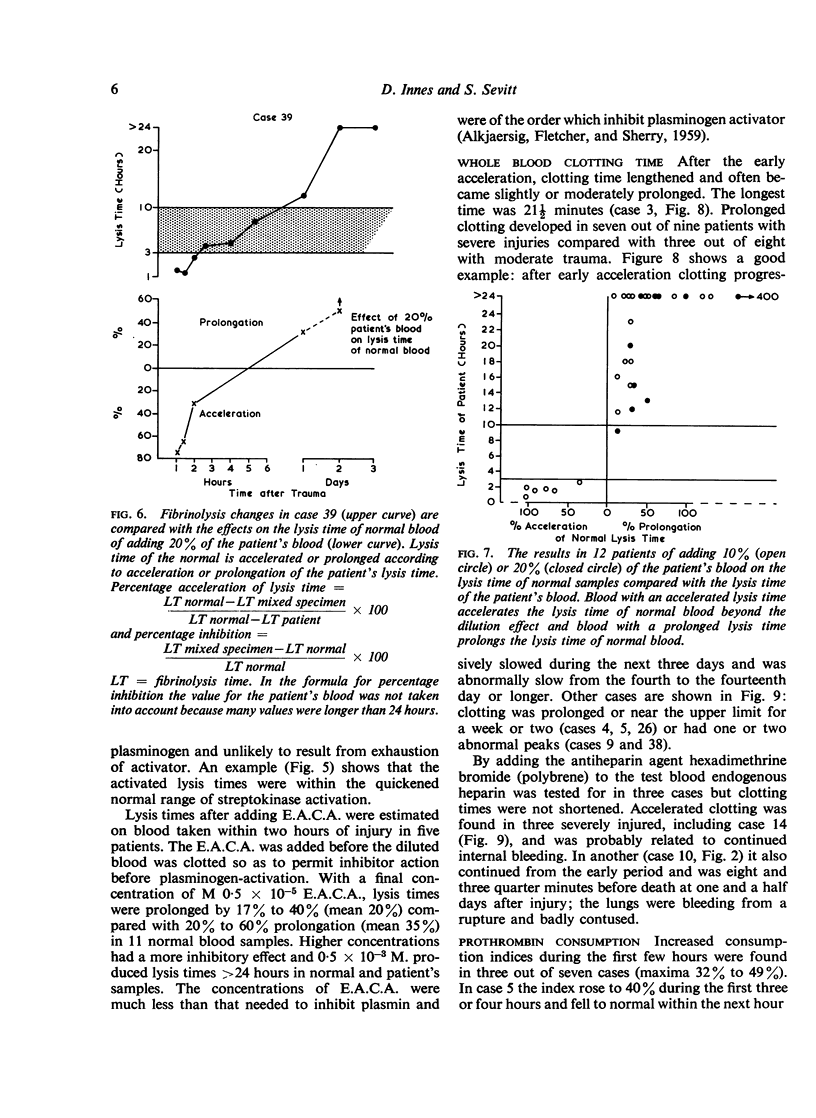
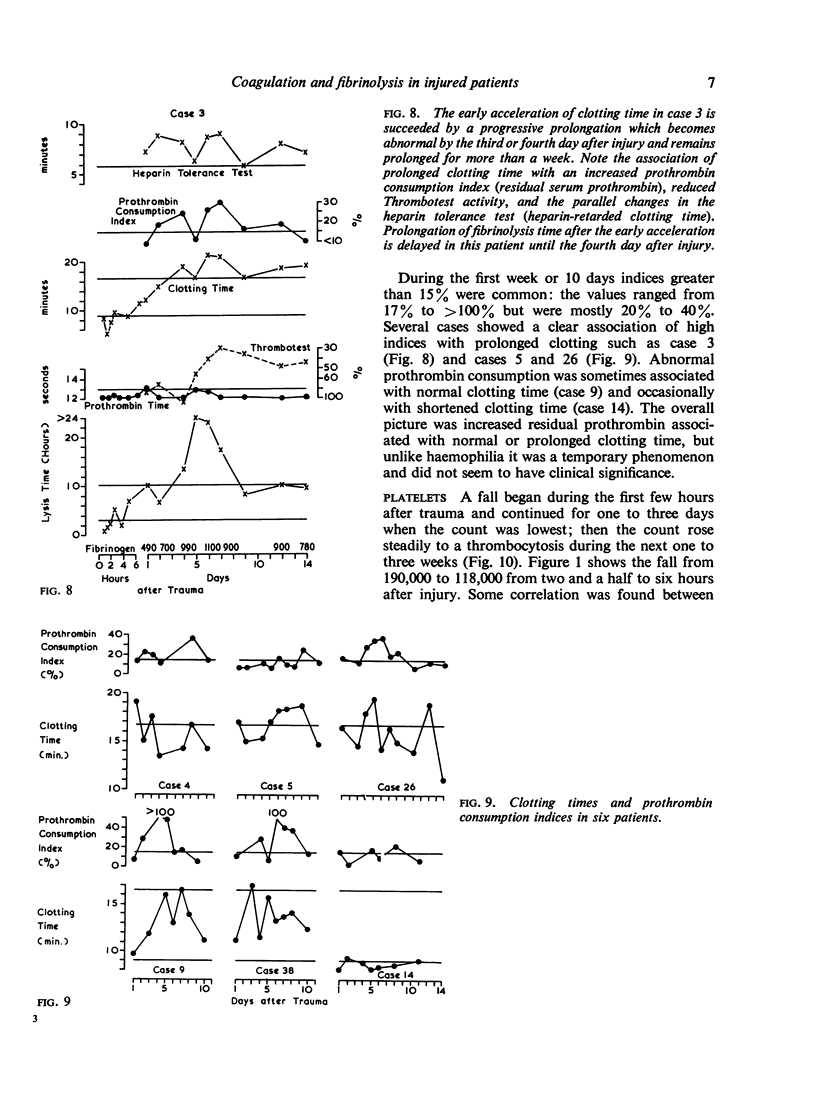
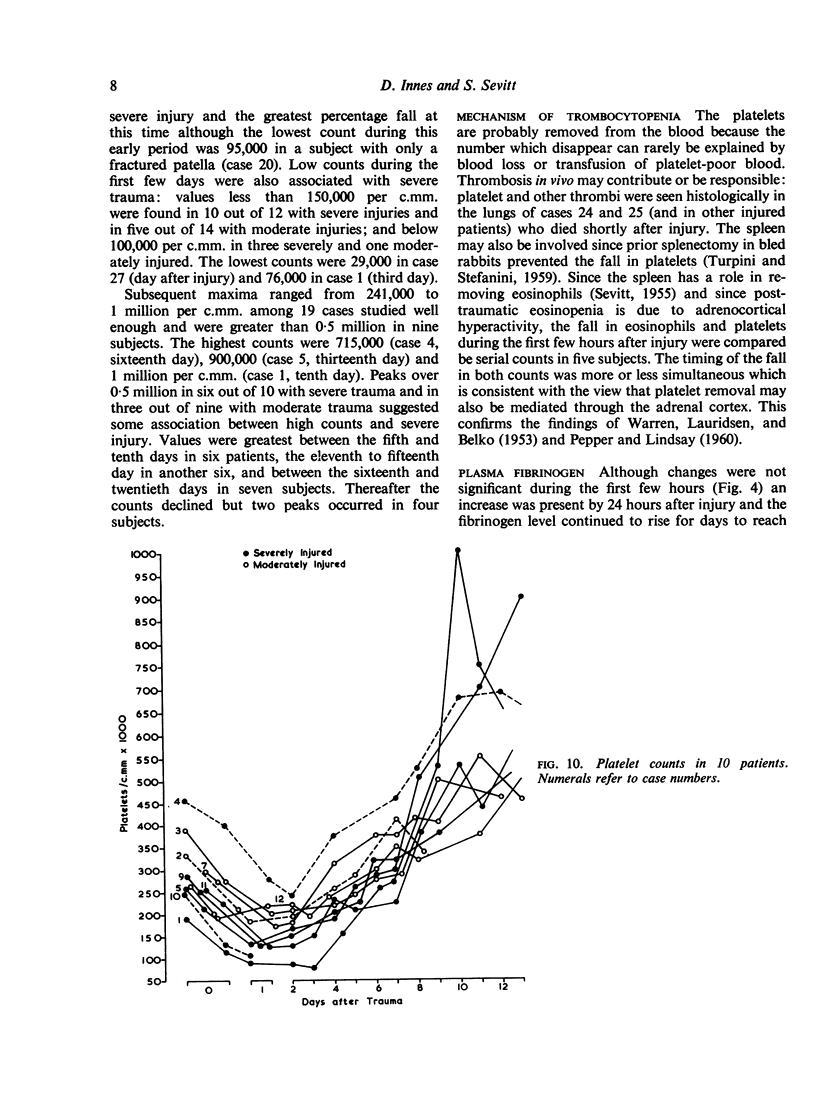
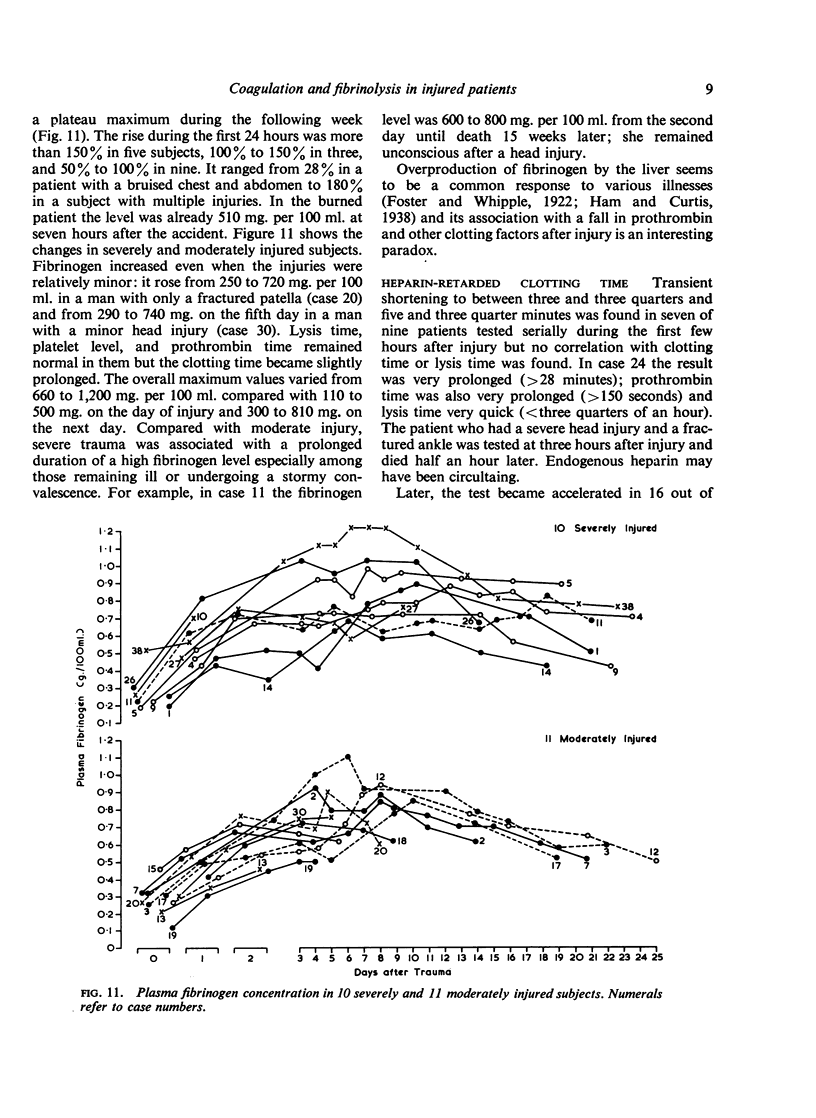
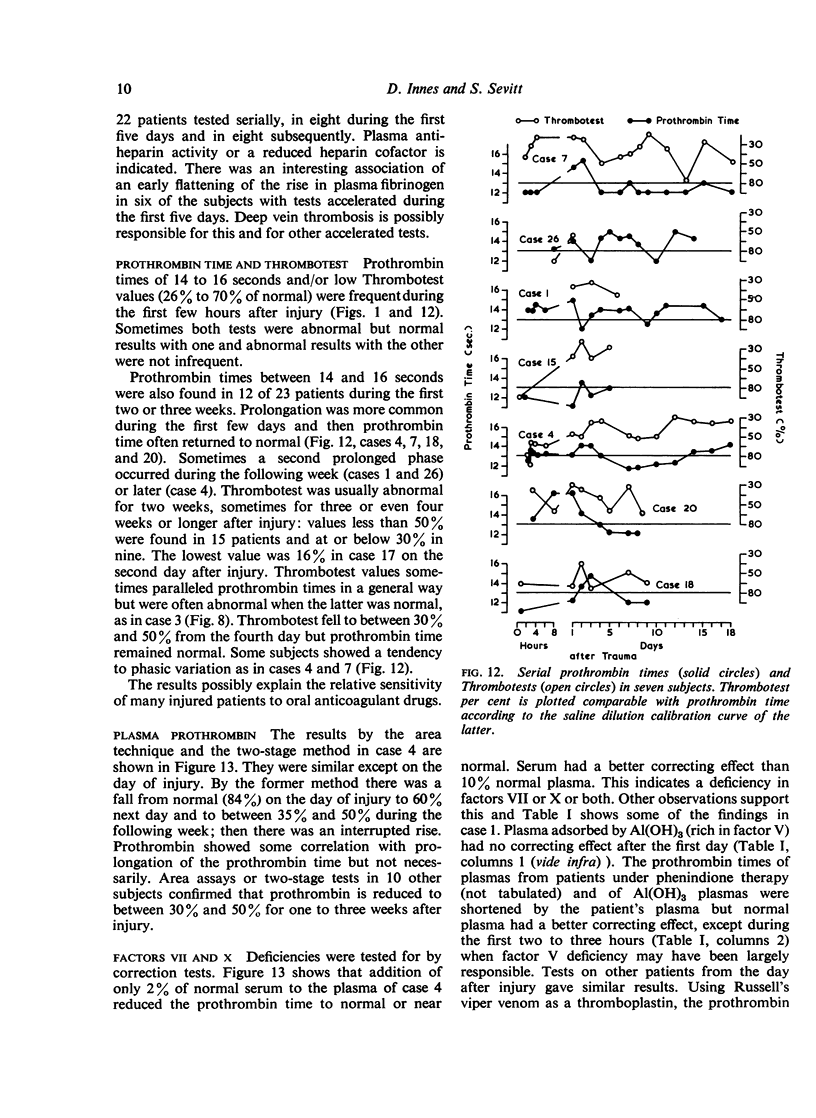
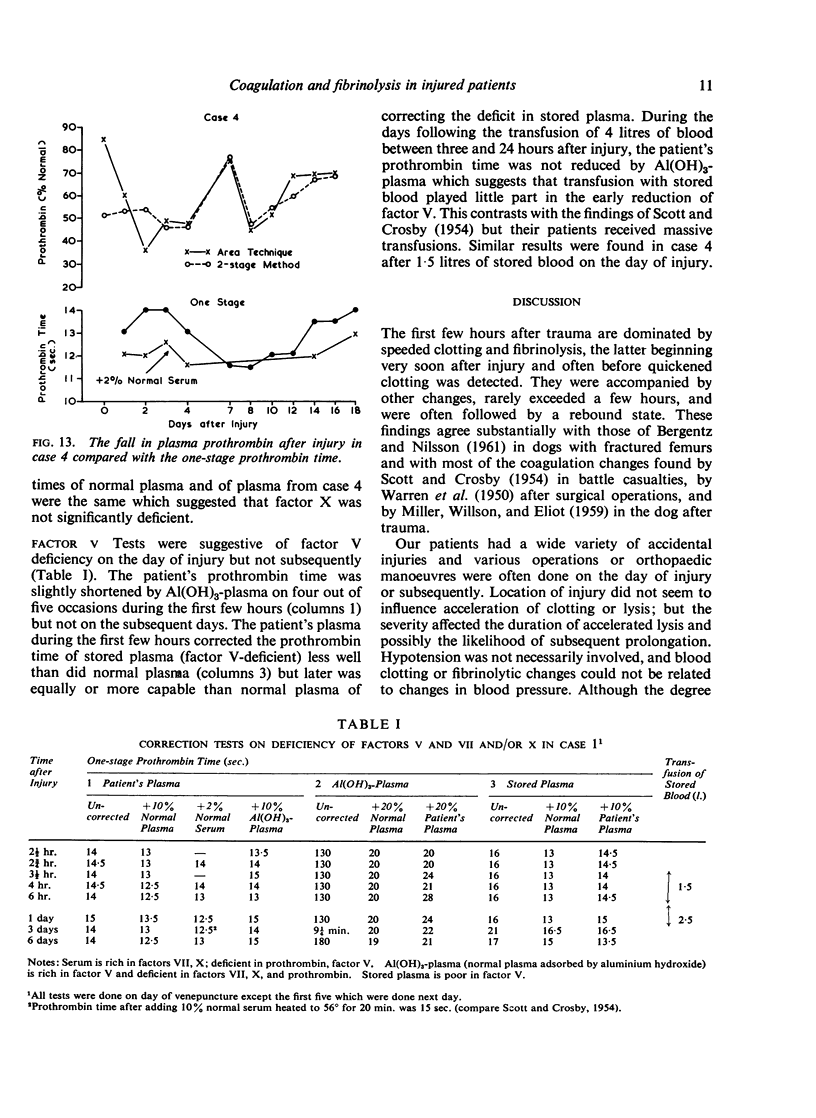
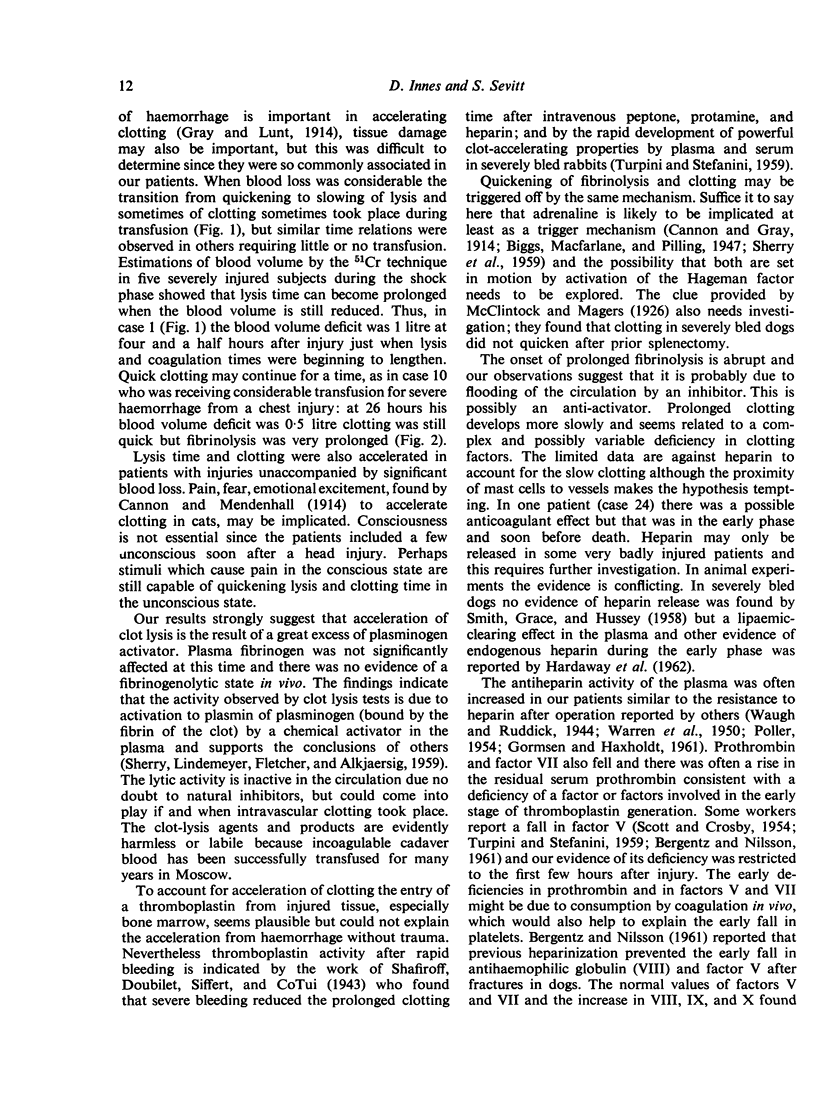
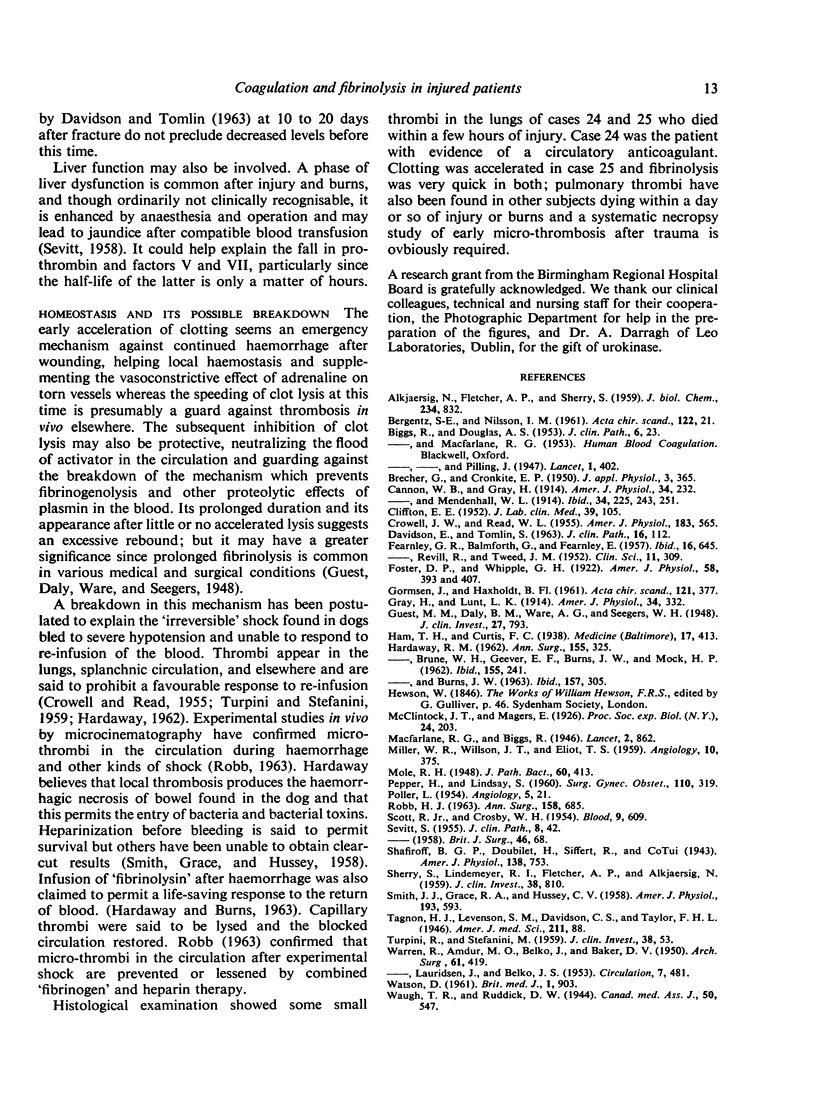
Selected References
These references are in PubMed. This may not be the complete list of references from this article.
- ALKJAERSIG N., FLETCHER A. P., SHERRY S. xi-Aminocaproic acid: an inhibitor of plasminogen activation. J Biol Chem. 1959 Apr;234(4):832–837. [PubMed] [Google Scholar]
- BIGGS R., DOUGLAS A. S. The thromboplastin generation test. J Clin Pathol. 1953 Feb;6(1):23–29. doi: 10.1136/jcp.6.1.23. [DOI] [PMC free article] [PubMed] [Google Scholar]
- BRECHER G., CRONKITE E. P. Morphology and enumeration of human blood platelets. J Appl Physiol. 1950 Dec;3(6):365–377. doi: 10.1152/jappl.1950.3.6.365. [DOI] [PubMed] [Google Scholar]
- CLIFFTON E. E. Variations in the proteolytic and the antiproteolytic reactions of serum: effect of disease, trauma, x-ray, anaphylactic shock, ACTH, and cortisone. J Lab Clin Med. 1952 Jan;39(1):105–121. [PubMed] [Google Scholar]
- CROWELL J. W., READ W. L. In vivo coagulation; a probable cause of irreversible shock. Am J Physiol. 1955 Dec;183(3):565–569. doi: 10.1152/ajplegacy.1955.183.3.565. [DOI] [PubMed] [Google Scholar]
- DAVIDSON E., TOMLIN S. The levels of the plasma coagulation factors after trauma and childbirth. J Clin Pathol. 1963 Mar;16:112–114. doi: 10.1136/jcp.16.2.112. [DOI] [PMC free article] [PubMed] [Google Scholar]
- FEARNLEY G. R., BALMFORTH G., FEARNLEY E. Evidence of a diurnal fibrinolytic rhythm; with a simple method of measuring natural fibrinolysis. Clin Sci. 1957 Nov;16(4):645–650. [PubMed] [Google Scholar]
- FEARNLEY G. R., REVILL R., TWEED J. M. Observations on the inactivation of fibrinolytic activity in shed blood. Clin Sci. 1952 Aug;11(3):309–314. [PubMed] [Google Scholar]
- GORMSEN J., HAXHOLDT B. F. Operative and postoperative changes in blood coagulation. Acta Chir Scand. 1961 Jun-Jul;121:377–383. [PubMed] [Google Scholar]
- Guest M. M., Daly B. M., Ware A. G., Seegers W. H. A STUDY OF THE ANTIFIBRINOLYSIN ACTIVITY IN HUMAN PLASMAS DURING PATHOLOGICAL STATES. J Clin Invest. 1948 Nov;27(6):793–794. doi: 10.1172/JCI102030. [DOI] [PMC free article] [PubMed] [Google Scholar]
- HARDAWAY R. M., BRUNE W. H., GEEVER E. F., BURNS J. W., MOCK H. P. Studies on the role of intravascular coagulation in irreversible hemorrhagic shock. Ann Surg. 1962 Feb;155:241–250. doi: 10.1097/00000658-196200000-00014. [DOI] [PMC free article] [PubMed] [Google Scholar]
- HARDAWAY R. M. The role of intravascular clotting in the etiology of shock. Ann Surg. 1962 Mar;155:325–338. doi: 10.1097/00000658-196203000-00001. [DOI] [PMC free article] [PubMed] [Google Scholar]
- MILLER W. R., WILLSON J. T., ELIOT T. S. Blood changes in the dog following trauma. Angiology. 1959 Oct;10:375–381. doi: 10.1177/000331975901000507. [DOI] [PubMed] [Google Scholar]
- PEPPER H., LINDSAY S. Responses of platelets, eosinophils, and total leucocytes during and following surgical procedures. Surg Gynecol Obstet. 1960 Mar;110:319–326. [PubMed] [Google Scholar]
- POLLER L. A heparin-retarded plasma clotting test. Angiology. 1954 Feb;5(1):21–26. doi: 10.1177/000331975400500104. [DOI] [PubMed] [Google Scholar]
- ROBB H. J. THE ROLE OF MICRO-EMBOLISM IN THE PRODUCTION OF IRREVERSIBLE SHOCK. Ann Surg. 1963 Oct;158:685–697. doi: 10.1097/00000658-196310000-00015. [DOI] [PMC free article] [PubMed] [Google Scholar]
- SCOTT R., Jr, CROSBY W. H. Changes in the coagulation mechanism following wounding and resuscitation with stored blood; a study of battle casualties in Korea. Blood. 1954 Jun;9(6):609–621. [PubMed] [Google Scholar]
- SEVITT S. The spleen and blood eosinopenia. J Clin Pathol. 1955 Feb;8(1):42–46. doi: 10.1136/jcp.8.1.42. [DOI] [PMC free article] [PubMed] [Google Scholar]
- SHERRY S., LINDEMEYER R. I., FLETCHER A. P., ALKJAERSIG N. Studies on enhanced fibrinolytic activity in man. J Clin Invest. 1959 May;38(5):810–822. doi: 10.1172/JCI103863. [DOI] [PMC free article] [PubMed] [Google Scholar]
- SMITH J. J., GRACE R. A., HUSSEY C. V. Coagulation mechanism and effect of heparin in hemorrhagic shock. Am J Physiol. 1958 Jun;193(3):593–598. doi: 10.1152/ajplegacy.1958.193.3.593. [DOI] [PubMed] [Google Scholar]
- TURPINI R., STEFANINI M. The nature and mechanism of the hemostatic breakdown in the course of experimental hemorrhagic shock. J Clin Invest. 1959 Jan 1;38(1 Pt 1):53–65. doi: 10.1172/JCI103795. [DOI] [PMC free article] [PubMed] [Google Scholar]
- WARREN R., AMDUR M. O., BELKO J., BAKER D. V. Postoperative alterations in the coagulation mechanism of the blood; observations on circulating thromboplastin. Arch Surg. 1950 Sep;61(3):419–432. doi: 10.1001/archsurg.1950.01250020424002. [DOI] [PubMed] [Google Scholar]
- WARREN R., LAURIDSEN J., BELKO J. S. Alterations in numbers of circulating platelets following surgical operation and administration of adrenocorticotropic hormone. Circulation. 1953 Apr;7(4):481–486. doi: 10.1161/01.cir.7.4.481. [DOI] [PubMed] [Google Scholar]
- Waugh T. R., Ruddick D. W. A Test for Increased Coagulability of the Blood. Can Med Assoc J. 1944 Jun;50(6):547–549. [PMC free article] [PubMed] [Google Scholar]


